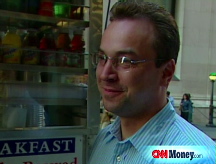Stock rebound: Testing the waters
Markets have historically bounced back after steep drops, but if you're looking to get back in to equities, look before you leap.
| MMA | 0.69% |
| $10K MMA | 0.42% |
| 6 month CD | 0.94% |
| 1 yr CD | 1.49% |
| 5 yr CD | 1.93% |
NEW YORK (CNN) -- Can we feel safe in the stock market again? Monday's record point gain for the Dow Jones industrial average - an eye-popping 936-digits on the Big Board - certainly gives us reassurance that 2008 won't be another 1929.
But market analysts warn investors still need to be vigilant, even if the rebound continues.
Like a rubber band stretched to its limit, stocks were poised to snap back Monday, as the market is prone to do after a collapse. And for investors, fear of missing the investment train's comeback climb replaced their fear of getting run over by the runaway train careening downhill.
"People are single-minded," said Phil Roth, Chief Technical Market Analyst at Miller Tabak & Co. of Washington's revised plan to inject capital directly into banks." They're thinking the banks are going to make it. Buy stocks!" Roth predicts the snap-back should extend for several days.
Consider, the Dow (INDU) had tumbled for eight consecutive days, losing 22% before Monday's 11% bounce.
In 2001 when the stock market reopened following the 9/11 terror attacks the Dow sank 14% in a week. The next week it rebounded 7%.
On Black Monday, October 19, 1987, the Dow collapsed 22.6% then snapped back 17% over the following two days.
"This is the knee-jerk rally," said Ralph Acampora, Director of Technical Studies at the New York Institute of Finance.
After the '87 Crash, Wall Street entered a bull market that climbed to new heights. But, the snapback in 2001 that occurred while the economy was in recession didn't last. By the Spring of 2002 stocks were tumbling, heading for a new low in October.
The big question for investors - to which no one has the answer is this: Did Friday mark a bottom for the market? We'll only know in hindsight, after stocks 're-test' the low. If the market declines without falling near Friday's low, that, analysts say, would be a bullish sign.
Acampora warns investors not to jump into the stock market too aggressively. "It's too early to say back the truck up, pile in," he said.
Investor confidence was shattered by the eight-day tumble, and analysts warn it will take time to rebuild that security.
"Will investors be confident overnight? Hell no," argued Acampora.
The credit freeze still needs to thaw for the global economy to move away from the edge of an abyss.
"The missing ingredient for a new bull market is a big drop in interest rates," said Roth.
U.S. Credit markets were closed Monday for Columbus Day while stock markets around the globe rallied. Three-month LIBOR (London Interbank Offered Rate), a key interest rate at which banks lend each other funds for three-months, dropped only slightly Tuesday morning to 4.64% from 4.75% Monday.
Another risk that hangs over the stock market is recession, which many economists say is now a certainty. During Monday's monster rally some of the biggest gainers were stocks of "cyclical" companies, those dependent upon the economy, which had suffered the worst beating during the past two weeks.
The bear market may not be finished, but some analysts are optimistic that the worst of the damage has been done.
"Panics don't happen at the top of a bear market, they happen at the bottom. It's an ending sign," said Frank Gretz, Chief Technical Analyst with Shields and Company.
If so, history is encouraging for the near-term. At bear-market bottoms the stock market has climbed an average of 33% in only 40 days, according to Standard and Poor's.
"I call it a Moses movement because basically in 40 days you recoup about a third of what you lost in the prior bear market," said Sam Stovall, Chief Investment Strategist at Standard and Poor's. ![]()


